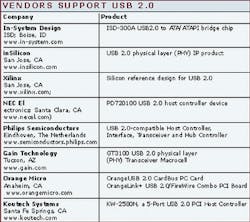Forum highlights high-speed USB
Designers of machine-vision and image-processing systems are confronted with several camera-interface choices, ranging from bus-based topologies such as IEEE-1394 (or FireWire) and USB 2 to single-link implementations such as RS-644 and Camera Link (see Vision Systems Design, July 2001, p. 47). While single-link implementations such as RS-644 and Camera Link will fill the needs of real-time applications, bus-based topologies such as IEEE-1394 (or FireWire) and USB 2 will fill the demands of many non-deterministic applications.
At the recent Intel Developer Forum, the main highlights related to USB 2.0, a bus-based interface that provides a maximum throughput of 480 Mbits/s, 40 times faster than its USB 1.1 predecessor. In addition, USB 2.0 offers plug-and-play capability, hot swap, and interoperability between USB 2.0 and USB 1.1 devices.
At the forum, Intel vice president Louis Burns showed a USB 2.0 digital video camera connected to a Pentium 4-based PC using an Intel prototype chipset with an integrated USB 2.0 controller. Burns said the chipset would enable deployment of USB 2.0 next year. The demo showed how the Ultra visual effects software from Serious Magic (www.seriousmagic.com) uses a Pentium PC with a USB 2.0 interface to deliver 30 frame/s video from a USB 2.0 camera from Opteon (Cambridge, MA).
A number of other vendors made USB 2 product announcements. Cypress Semiconductor (San Jose, CA), for example, which recently introduced its EZ-USB FX2 USB 2.0 microcontroller, has now announced that it will acquire In-System Design (Boise, ID), a system-on-chip design company that sells a USB 2.0-to-ATA/ATAPI bridge chip.
To provide better support for USB 2.0 board developers, NEC Electronics (Santa Clara, CA) and SoftConnex Technologies (Fremont, CA) will integrate SoftConnex's USBLink Host software with the NEC µPD720100 host controller. The µPD720110 device incorporates a physical layer function for simple USB 2.0 while SoftConnex's USBLink Host is comprised of the USB stack and driver running under Linux, LynxOS, MS-DOS, QNX and VxWorks.
Similarly, NetChip Technology (Mountain View, CA) will work with Adaptec (Milpitas, CA) to ensure interoperability and compatibility of USB 2.0 products. Already, Adaptec offers a family of USB 2.0 host bus adapters and hub devices and drivers for Windows 98/ME/2000, while a number of other USB 2.0 peripherals are using NetChip's NET2270 device controller.

